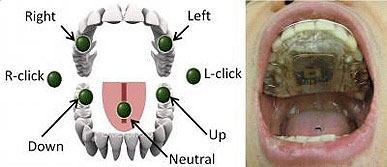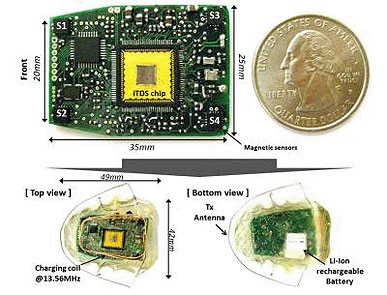The Tongue Drive System is a wireless device that enables people with high-level spinal-cord injuries to operate a computer and manoeuvre an electrically powered wheelchair simply by moving their tongues.
The newest prototype allows users to wear an inconspicuous dental retainer embedded with sensors to control the system.
The sensors track the location of a tiny magnet attached to the tongues of users. In earlier versions of the Tongue Drive System, the sensors that track the movement of the magnet on the tongue were mounted on a headset worn by the user.
‘By moving the sensors inside the mouth, we have created a tongue drive system with increased mechanical stability and comfort that is nearly unnoticeable,’ said Maysam Ghovanloo, an associate professor in the School of Electrical and Computer Engineering at the Georgia Institute of Technology.
The new intra-oral Tongue Drive System was presented and demonstrated on 20 February 2012 at the IEEE International Solid-State Circuits Conference in San Francisco.

The new dental appliance contains magnetic field sensors mounted on its four corners that detect movement of a tiny magnet attached to the tongue. It also includes a rechargeable lithium-ion battery and an induction coil to charge the battery. The circuitry fits in the space available on the retainer, which sits against the roof of the mouth and is covered with an insulating, water-resistant material and vacuum moulded inside standard dental acrylic.
‘One of the problems we encountered with the earlier headset was that it could shift on a user’s head and the system would need to be recalibrated,’ explained Ghovanloo. ‘Because the dental appliance is worn inside the mouth and moulded from dental impressions to fit tightly around an individual’s teeth with clasps, it is protected from these types of disturbances.’
When in use, the output signals from the sensors are wirelessly transmitted to an iPod or an iPhone. Software installed on the iPod interprets the user’s tongue commands by determining the relative position of the magnet with respect to the array of sensors in real time. This information is used to control the movements of a cursor on the computer screen or to substitute for the joystick function in a powered wheelchair.

Ghovanloo and his team have also created a universal interface for the intra-oral Tongue Drive System that attaches directly to a standard electric wheelchair. The interface not only holds the iPod but also wirelessly receives the sensor data and delivers it to the iPod, connects the iPod to the wheelchair, charges the iPod and includes a container where the dental retainer can be placed at night for charging.
In preliminary tests, the intra-oral device exhibited an increased signal-to-noise ratio, even when a smaller magnet was placed on the tongue. This improved sensitivity could allow additional commands to be programmed into the system. The existing Tongue Drive System that uses a headset interprets commands from seven different tongue movements.
The researchers plan to begin testing the usability of the intra-oral Tongue Drive System by able-bodied individuals soon and then move onto clinical trials to test its usability by people with high-level spinal-cord injuries.





Swiss geoengineering start-up targets methane removal
No mention whatsoever about the effect of increased methane levels/iron chloride in the ocean on the pH and chemical properties of the ocean - are we...